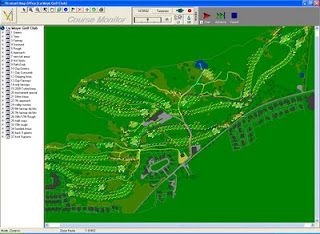Three large pumps distribute the water around the course at a pressure of 150 psi through a network of pipes up to the irrigation sprinkler heads. The system has been designed to ensure that water is applied accurately and wastage is kept to a minimum. Low trajectory sprinklers are used in the most exposed spots to ensure the wind has a minimal impact. A central computer located in the maintenance facility is used to program and run the system.
The course has been mapped using GPS with every sprinkler head, valve and pipe marked. Any sprinkler head can be turned on either at the base station, manually at the head or by using a remote control unit. The system can be programmed to run any number of heads in any sequence starting at any time.
Record keeping is made easy with this system as it automatically maintains detailed records of application timings and quantities giving weekly, monthly or annual aggregated totals. A weather station is also linked in to the system providing real time data of wind speed and direction, precipitation, humidity and temperature. From this information evapo-transpiration rates are calculated which the system can use to determine how much water should be applied to maintain optimum soil moisture levels.
 Daily weather records are automatically maintained
Daily weather records are automatically maintainedAs you can see, our system makes it easy for us to apply water accurately and at the rates we want. However, we must remember that this does not mean we always want the golf course to be green and lush. Inappropriate and overuse of the irrigation system can cause serious long term problems to turf which can take years to rectify. We aim to use the system only when the health of the desirable grass plants would otherwise suffer, not just to soften the greens so the ball is easier to control or to green up the fairways to make them look "nice".
In late winter and very early spring we rarely irrigate even in extended dry periods because the cold water only serves to lower soil temperatures causing what little growth we have at that time of the year to stop completely. Much better dry, firm and slow growth than moist, soft and no growth! We generally irrigate in all dry spells throughout the mid-spring/early summer period to ensure the turf has optimal growth conditions to recover from the stresses of winter. Once mid summer comes we will relax the irrigation to allow the turf to dry out somewhat in order to stress the undesirable grass species and to encourage the fine grasses to develop deep rooting. Without doing this the shallow rooting grass species - which also happen to be the least suitable grasses for golf - are allowed to colonise and take over the sward. In general terms we are trying to present firm and consistent surfaces which have a dense cover of fine grasses. Our watering strategy is tailored with this in mind so please don't be surprised if surfaces get a bit brown in colour come mid summer, it will not mean the irrigation system is broken, we will merely be letting nature take it's course!
For more information on this topic please click on the title word IRRIGATION at the top of this post.
In late winter and very early spring we rarely irrigate even in extended dry periods because the cold water only serves to lower soil temperatures causing what little growth we have at that time of the year to stop completely. Much better dry, firm and slow growth than moist, soft and no growth! We generally irrigate in all dry spells throughout the mid-spring/early summer period to ensure the turf has optimal growth conditions to recover from the stresses of winter. Once mid summer comes we will relax the irrigation to allow the turf to dry out somewhat in order to stress the undesirable grass species and to encourage the fine grasses to develop deep rooting. Without doing this the shallow rooting grass species - which also happen to be the least suitable grasses for golf - are allowed to colonise and take over the sward. In general terms we are trying to present firm and consistent surfaces which have a dense cover of fine grasses. Our watering strategy is tailored with this in mind so please don't be surprised if surfaces get a bit brown in colour come mid summer, it will not mean the irrigation system is broken, we will merely be letting nature take it's course!
For more information on this topic please click on the title word IRRIGATION at the top of this post.





